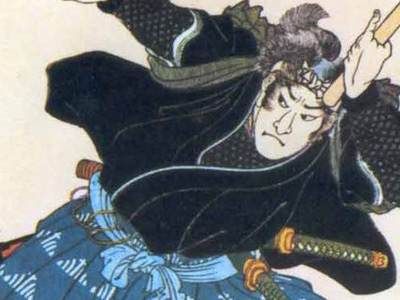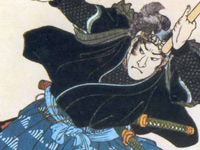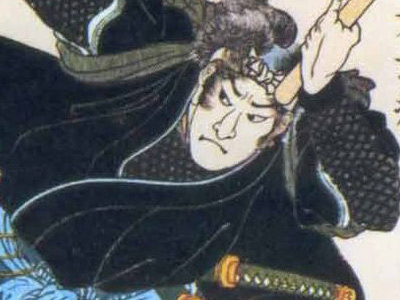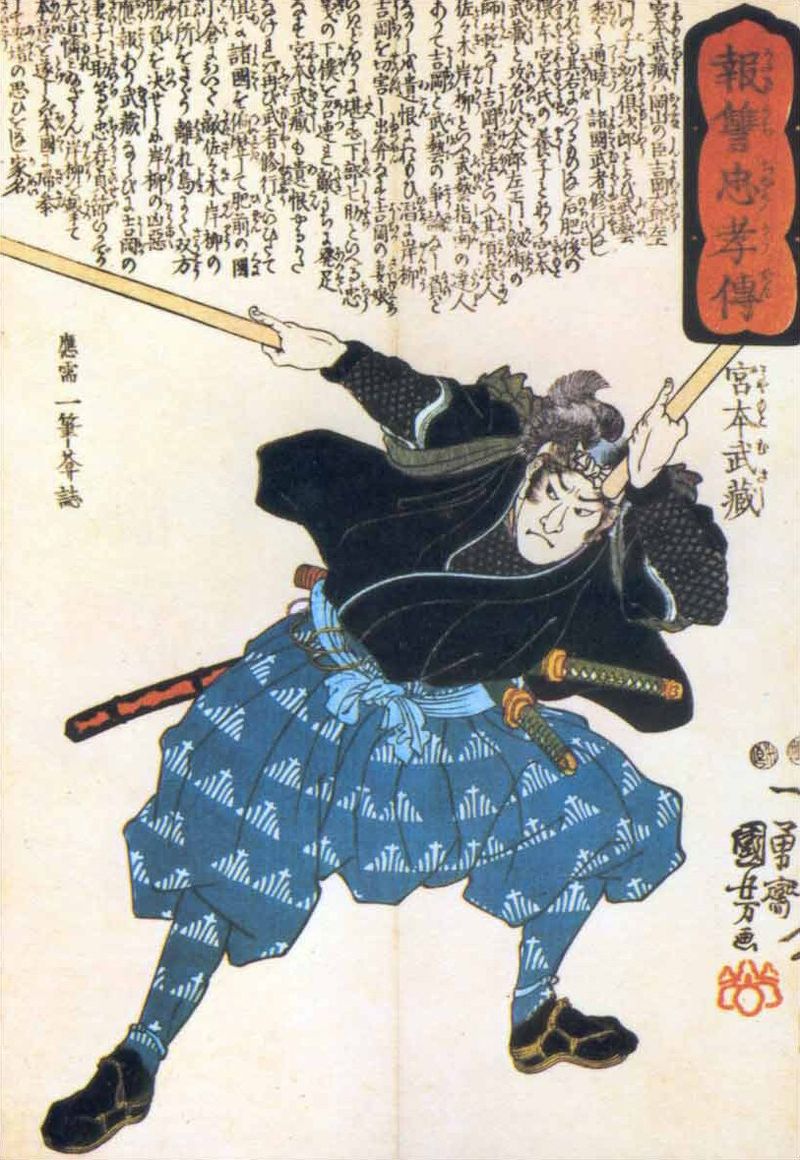Miyamoto Musashi (1584-1645)

Later life and death
Six years later, in 1633, Musashi began staying with Hosokawa Tadatoshi, daimyo of Kumamoto Castle, who had moved to the Kumamoto fief and Kokura, to train and paint. Ironically, it was at this time that the Hosokawa lords were also the patrons of Musashi's chief rival, Sasaki Kojirō. While there he engaged in very few duels; one would occur in 1634 at the arrangement of Lord Ogasawara, in which Musashi defeated a lance specialist by the name of Takada Matabei. Musashi would officially become the retainer of the Hosokowa lords of Kumamoto in 1640. The Niten Ki records "[he] received from Lord Tadatoshi: 17 retainers, a stipend of 300 koku, the rank of ōkumigashira 大組頭, and Chiba Castle in Kumamoto as his residence."
In the second month of 1641, Musashi wrote a work called the Hyoho Sanju Go ("Thirty-five Instructions on Strategy") for Hosokawa Tadatoshi; this work overlapped and formed the basis for the later The Book of Five Rings. This was the year that his third son, Hirao Yoemon, became Master of Arms for the Owari fief. In 1642, Musashi suffered attacks of neuralgia, foreshadowing his future ill-health. In 1643 he retired to a cave named Reigandō as a hermit to write The Book of Five Rings. He finished it in the second month of 1645. On the twelfth of the fifth month, sensing his impending death, Musashi bequeathed his worldly possessions, after giving his manuscript copy of The Book of Five Rings to the younger brother of Terao Magonojo, his closest disciple. He died in Reigandō cave around June 13, 1645 (Shōhō 3, 30th day of the 4th month). The Hyoho senshi denki described his passing:
At the moment of his death, he had himself raised up. He had his belt tightened and his wakizashi put in it. He seated himself with one knee vertically raised, holding the sword with his left hand and a cane in his right hand. He died in this posture, at the age of sixty-two. The principal vassals of Lord Hosokawa and the other officers gathered, and they painstakingly carried out the ceremony. Then they set up a tomb on Mount Iwato on the order of the lord.
Musashi died of what is believed to be thoracic cancer, and was not killed in combat. He died peacefully after finishing the Dokkōdō ("The Way of Walking Alone", or "The Way of Self-Reliance"), 21 precepts on self-discipline to guide future generations.
His body was interred in armor within the village of Yuge, near the main road near Mount Iwato, facing the direction the Hosokawas would travel to Edo; his hair was buried on Mount Iwato itself. (NB - Mount Iwato is part of the Mount Kinpo range in Kumamoto and actually where Musashi wrote The Book of Five Rings in the Reigando cave. His grave is not there, but about 45 minutes away, to the east and on the other side of Kumamoto, in the Musashizuka area). Some of his remains were given to Mimasaka so that he could be buried (in part) with his parents. The Mimasaka graves are located in the precincts of Musashi Shrine.
Nine years later, a major source about his life — a monument with a funereal eulogy to Musashi — was erected in Kokura by Miyamoto Iori; this monument was called the Kokura hibun. An account of Musashi's life, the Niten-ki 二天記, was published in Kumamoto in 1776, by Toyota Kagehide, based on the recollections of his grandfather Toyota Masataka, who was a second generation pupil of Musashi.
HISTORY

RESOURCES
This article uses material from the Wikipedia article "Miyamoto Musashi", which is released under the Creative Commons Attribution-Share-Alike License 3.0.
© Stories Preschool. All Rights Reserved.










